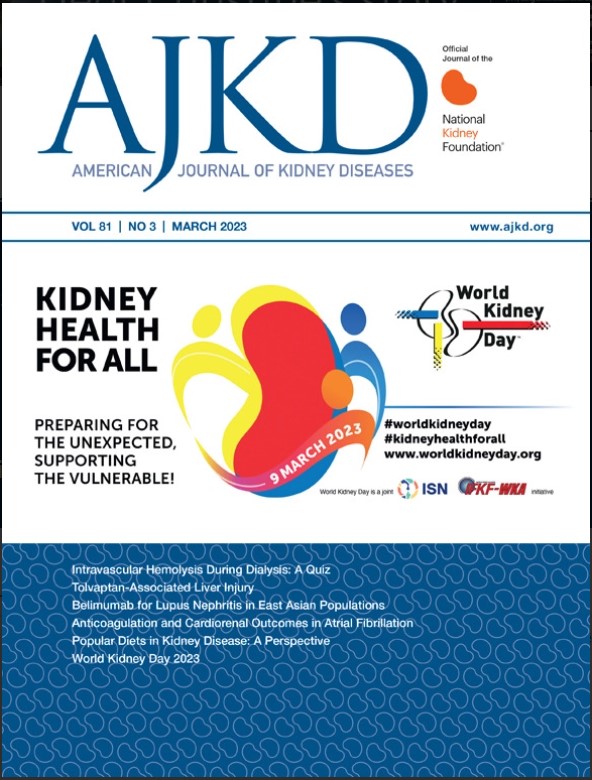IgM Variant of Proliferative Glomerulonephritis With Monoclonal Immunoglobulin Deposits: A Case Series
IF 9.4
1区 医学
Q1 UROLOGY & NEPHROLOGY
引用次数: 0
Abstract
Rationale & Objective
Most deposits in proliferative glomerulonephritis with monoclonal immunoglobulin deposits (PGNMID) are of the IgG class. The IgM variant (PGNMID-IgM) is very rare, and data are mostly derived from single case reports or cases associated with B-cell lymphoproliferative disorders. We describe the clinicopathologic characteristics and outcomes among cases of PGNMID-IgM.
Study Design
Case series.
Setting & Participants
23 PGNMID-IgM cases identified from kidney pathology archives. PGNMID-IgM was defined by glomerulonephritis with glomerular granular monotypic IgM deposits after excluding cryoglobulinemic glomerulonephritis and intracapillary monoclonal deposits disease.
Findings
Seventy-eight percent of the cases were male, they had a median age of 72 years, and they had presented with proteinuria (median, 3.1 g/day), hematuria (91%), and reduced estimated glomerular filtration rate (median serum creatinine, 1.9 mg/dL). Hypocomplementemia was present in 31% of cases. The underlying hematologic condition for all cases was monoclonal gammopathy of renal significance (MGRS). Serum protein electrophoresis/serum immunofixation (SPEP/SIF) detected the nephropathic monoclonal immunoglobulin (MIg) in 27% of cases whereas matrix-assisted laser desorption/ionization time-of-flight mass spectrometry (MALDI-TOF) detected the nephropathic IgM in 4 of 7 tested patients. Kidney biopsy revealed membranoproliferative glomerulonephritis (83%) with nonorganized glomerular monotypic IgM (100%) and C3 deposition (96%), but C1q deposition was rare. Seventeen percent received symptomatic treatment alone, 17% received steroids alone, and 65% received other immunosuppressive therapy (mostly rituximab-based therapy). Follow-up (median, 40 months) was available for all patients. The median kidney and patient survivals were 44 and 158 months, respectively. Three patients underwent kidney transplantation, and all had recurrence, in 2 cases within a month.
Limitations
Small sample size, retrospective design, nonstandardized clinical management.
Conclusions
PGNMID-IgM mostly affects elderly men and is associated with MGRS with a low detection rate of the circulating nephropathic MIg on SPEP/SIF, which may be improved by MALDI-TOF. Kidney survival is guarded, with a high rate of early recurrence after transplant although overall survival is favorable. The pathogenesis remains unknown, but it likely involves local activation of alternative or lectin pathways of complement system by the monotypic IgM.
Plain-Language Summary
The IgM variant of proliferative glomerulonephritis with monoclonal immunoglobulin deposits (PGNMID-IgM) is very rare, and data on its clinicopathologic and outcome characteristics are scanty. This study of 23 patients with PGNMID-IgM identified in the Mayo Clinic pathology archives revealed that most patients were elderly White males who presented with proteinuria, hematuria, and reduced kidney function. The underlying hematologic condition was monoclonal gammopathy of renal significance in all cases, and the detection rate of the circulating nephropathic monoclonal immunoglobulin with serum protein electrophoresis/serum immunofixation was low but was increased using matrix-assisted laser desorption/ionization time-of-flight mass spectrometry. Pathologically, all cases exhibited nonorganized glomerular monotypic IgM, most with a membranoproliferative glomerulonephritis pattern. Outcome analysis revealed a guarded kidney survival (median, 44 months), a high rate of early recurrence after transplant, and favorable patient survival (158 months).
伴有单克隆免疫球蛋白沉积的增殖性肾小球肾炎IgM变异:一个病例系列
理由与目的:增殖性肾小球肾炎伴单克隆免疫球蛋白沉积(PGNMID)多为IgG类。IgM变体(PGNMID-IgM)非常罕见,数据主要来自单个病例报告或与b细胞淋巴增生性疾病相关的病例。我们描述了PGNMID-IgM病例的临床病理特征和结果。研究设计:病例系列。环境和参与者:从肾脏病理档案中发现23例PGNMID-IgM病例。排除冷球蛋白血症性肾小球肾炎和毛细血管内单克隆沉积病后,PGNMID-IgM定义为肾小球肾炎伴肾小球颗粒型单型IgM沉积。结果:78%的病例为男性,他们的中位年龄为72岁,表现为蛋白尿(中位3.1 g/天)、血尿(91%)和eGFR降低(中位血清肌酐1.9 mg/dL)。31%的病例存在补体不足。所有病例的基础血液学状况均为肾性单克隆伽玛病(MGRS)。血清蛋白电泳/血清免疫固定(SPEP/SIF)检测到肾病型IgM的比例为27%,而基质辅助激光解吸/电离飞行时间质谱(MALDI-TOF)检测到肾病型IgM的比例为4 / 7。肾活检显示MPGN(83%)伴无组织肾小球单型IgM(100%)和C3沉积(96%),而C1q沉积罕见。17%的人单独接受对症治疗,17%单独接受类固醇治疗,65%接受其他免疫抑制治疗(主要是基于利妥昔单抗的治疗)。所有患者均可随访(中位40个月)。肾脏和患者的中位生存期分别为44个月和158个月。3例患者接受了肾移植,其中2例在1个月内复发。局限性:样本量小,回顾性设计,临床管理不规范。结论:PGNMID-IgM主要影响老年男性,与MGRS相关,SPEP/SIF循环肾病MIg检出率较低,MALDI-TOF可改善这种情况。移植后早期复发率高,肾脏生存受到保护,而总体生存是有利的。发病机制尚不清楚,但可能与单型IgM局部激活补体的替代或凝集素途径有关。
本文章由计算机程序翻译,如有差异,请以英文原文为准。
求助全文
约1分钟内获得全文
求助全文
来源期刊

American Journal of Kidney Diseases
医学-泌尿学与肾脏学
CiteScore
20.40
自引率
2.30%
发文量
732
审稿时长
3-8 weeks
期刊介绍:
The American Journal of Kidney Diseases (AJKD), the National Kidney Foundation's official journal, is globally recognized for its leadership in clinical nephrology content. Monthly, AJKD publishes original investigations on kidney diseases, hypertension, dialysis therapies, and kidney transplantation. Rigorous peer-review, statistical scrutiny, and a structured format characterize the publication process. Each issue includes case reports unveiling new diseases and potential therapeutic strategies.
 求助内容:
求助内容: 应助结果提醒方式:
应助结果提醒方式:


